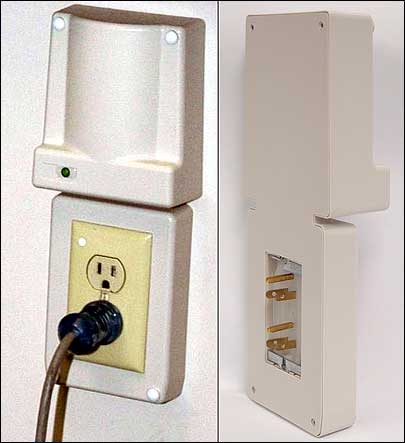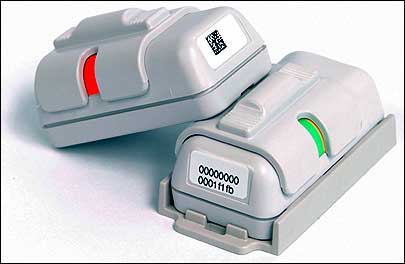Southeastern Regional Medical Center (SRMC) in Lumberton, N.C., has contracted RadarFind to install an asset-tracking system that uses active RFID tags and interrogators operating in the 902 to 928 MHz range. The tags communicate with readers that plug into standard AC outlets and have a design that keeps both outlet sockets available for use by other devices. The hospital hopes the system can help it reduce its spending.
David Sumner, SRMC’s VP of strategic management and support services, says the hospital currently relies on employees taking periodic manual inventory of important devices such as wheelchairs and infusion pumps. But that system takes too much time and produces erroneous data, he says, since many assets can not be easily located and, thus, might not be counted. As a result, superfluous replacement equipment might be ordered.

“Our impetus is to have more timely, accurate assessments [of inventory levels],” Sumner says. “That will minimize the challenge of performing inventory” and reduce equipment costs. But another important goal in deploying the system, he adds, is to minimize the frustrations caregivers, clinical technicians and other staff members feel when they are unable to quickly locate a piece of equipment. “If a nurse needs a piece of equipment, I don’t want [her] to spend an hour looking for it.”
In 2006, Wayne Memorial Hospital, a 316-bed facility in Goldsboro, N.C., deployed RadarFind’s system and was able to save more than $300,000 in equipment expenses within a year of installation (see At Wayne Memorial, RFID Pays for Itself).
RadarFind’s active ultrahigh-frequency (UHF) RFID transponders use multiple-input, multiple-output (MIMO) communication. MIMO is a wireless communication technique utilizing multiple analog signal paths among multiple antennas to transmit and receive data. The interrogators’ range can be set from 3 to 150 feet. Once they receive tag data, the readers pass that information up to devices that RadarFind calls collectors. Typically, one collector is installed on each floor of a facility. The readers can communicate with the collectors either by transmitting data wirelessly over the 902-928 MHz RF band, or by sending information across the power wiring. The collectors then pass the data, via a local area network, to a RadarFind server.
Each RadarFind asset tag is encoded with a unique ID number, transmitted by the tag, and also features a switch to indicate the asset’s condition. When the asset is clean and available for use, a nurse slides a plastic cover to expose a green sticker. This also causes the tag to modulate its signal to denote that the asset is ready for use, so that personnel using the RadarFind software to view a floor plan of the facility can observe both the asset’s location and its status.
Once a nurse begins using the asset, she slide the switch to reveal a yellow sticker. This indicates to staff passing by, or to those viewing the floor plan through the software, that the asset has been assigned to a patient and is not otherwise available. Once the asset is done being used, the nurse moves the lever to reveal a red sticker, indicating the asset should be picked up and moved to a cleaning facility within the hospital. Hospitals can use the status button to help ensure devices are cleaned before each use, to prevent the spread of infection. A specially designed asset tag for wheelchairs comes with electric-field sensing capabilities able to detect if a patient is in a wheelchair.
RadarFind executives claim the tags have a battery lifespan of approximately six years. The batteries are not replaceable, though a RadarFind spokesperson says hospitals will likely replace many tagged assets before a tag’s battery life ends.

Charles Brady, SRMC’s director of clinical engineering, says the hospital has purchased 1,000 RadarFind tags, and will begin attaching them this spring to high-value assets, including wheelchairs and infusion pumps. The RadarFind infrastructure of interrogators and collectors should be installed, and the tracking system implemented, by June of this year.
According to Brady, the hospital would like to track another 1,000 pieces of mobile equipment—items such as handheld radios used for communications—but that the RadarFind tag’s size (2.5 inches long by 1.25 inches wide) and $40 price tag make such a use impractical. However, he notes, RadarFind is developing a smaller tag that should cost less and work for tracking smaller assets. According to the vendor, the smaller tag should be available later this year.
Brady says the hospital is spending $229,000 on the RadarFind system, and will also pay the company an annual $10,000 fee for system support and upgrades. He thinks the facility will see a return on its investment in the system within two years, through savings in equipment costs and the staff overtime currently spent searching for assets.
Another N.C. hospital has also recently signed on to use the RadarFind system. Halifax Regional Medical Center, in Roanoke Rapids, has 206 beds and intends to track wheelchairs, IV pumps and other medical equipment. Its initial deployment, employing 1,000 tags, is set to begin in March.

